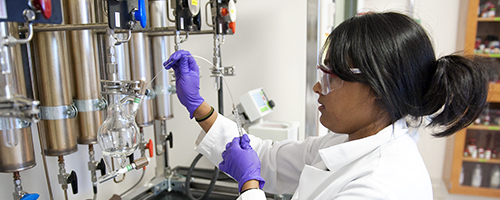Document Type
Conference Proceeding
Publication Date
4-13-2009
Publication Title
Biomacromolecules
Abstract
Approaches to the fabrication of surfaces that combine methods for the topographic patterning of soft materials with opportunities for facile, post-fabrication chemical functionalization could contribute significantly to advances in biotechnology and a broad range of other areas. Here, we report methods that can be used to introduce well defined nano- and microscale topographic features to thin films of reactive polymers containing azlactone functionality using nanoimprint lithography (NIL). We demonstrate that NIL can be used to imprint topographic patterns into thin films of poly(2-vinyl-4,4- dimethylazlactone) and a copolymer of methyl methacrylate and 2-vinyl- 4,4-dimethylazlactone using silicon masters having patterns of grooves and ridges ranging in width from 400 nm to 2μm, demonstrating the potential f this method to transfer patterns to films of these reactive polymers over a range of feature sizes and densities. We demonstrate further that the azlactone functionality of these polymers survives temperatures and pressures associated with NIL, and that topographically patterned films can be readily functionalized post-fabrication by treatment of surface-accessible azlactone functionality with small molecules and polymers containing primary amines. The results of experiments in which NIH-3T3 cells were seeded onto films imprinted with lined patterns having a pitch of 4 demonstrated that cells attach and proliferate on these azlactone-containing films and that they align in the direction of the imprinted pattern. Finally, we demonstrate that the treatment of these materials with amine-functionalized poly(ethylene glycol) (PEG) can be used to create regions of topographically patterned films that prevent cell adhesion. The results of this study suggest approaches to the functionalization of topographically patterned surfaces with a broad range of chemical functionality (e.g., peptides, proteins, carbohydrates, etc.) of biotechnological interest. The ability to manipulate and define both the physical topography and chemical functionality of these reactive materials could provide opportunities to investigate the combined effects of substrate topography and chemical functionality on cell behavior and may also be useful in a broad range of other applications.
Volume
10
Issue
4
First Page
994
Last Page
1003
DOI
10.1021/bm900045c
ISSN
15257797
Recommended Citation
Fredin, Nathaniel J.; Broderick, Adam H.; Buck, Maren E.; and Lvnn, David M., "Nano-Imprinted Thin Films of Reactive, Azlactone-Containing Polymers: Combining Methods for the Topographic Patterning of Cell Substrates with Opportunities for Facile Post-Fabrication Chemical Functionalization" (2009). Chemistry: Faculty Publications, Smith College, Northampton, MA.
https://scholarworks.smith.edu/chm_facpubs/39



Comments
Peer reviewed accepted manuscript.